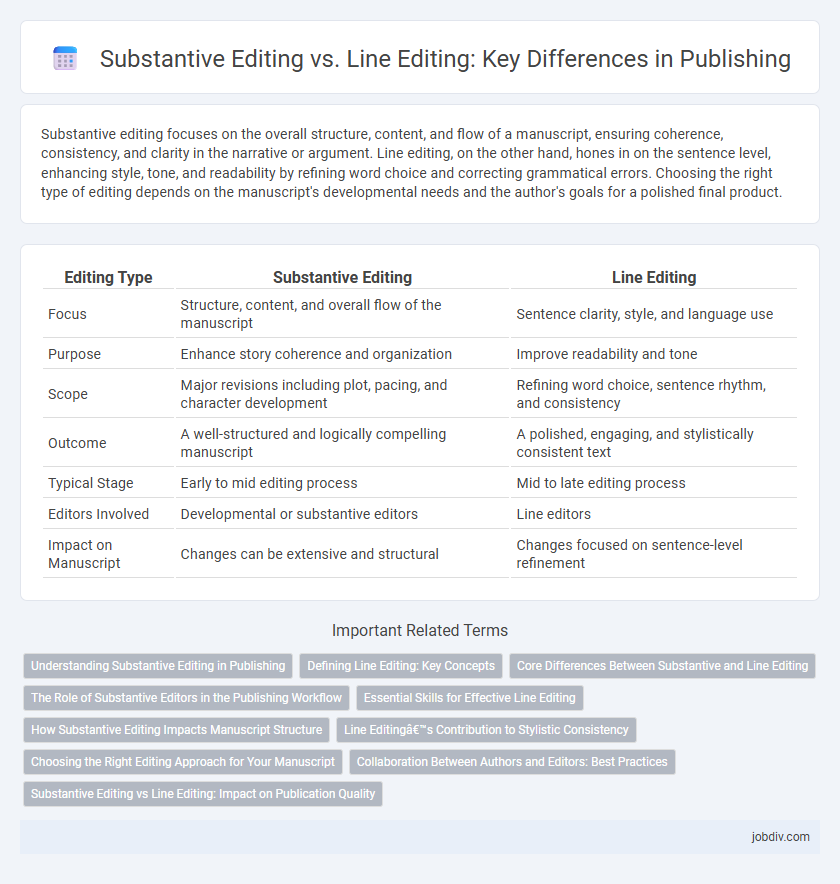Substantive editing focuses on the overall structure, content, and flow of a manuscript, ensuring coherence, consistency, and clarity in the narrative or argument. Line editing, on the other hand, hones in on the sentence level, enhancing style, tone, and readability by refining word choice and correcting grammatical errors. Choosing the right type of editing depends on the manuscript's developmental needs and the author's goals for a polished final product.
Table of Comparison
| Editing Type | Substantive Editing | Line Editing |
|---|---|---|
| Focus | Structure, content, and overall flow of the manuscript | Sentence clarity, style, and language use |
| Purpose | Enhance story coherence and organization | Improve readability and tone |
| Scope | Major revisions including plot, pacing, and character development | Refining word choice, sentence rhythm, and consistency |
| Outcome | A well-structured and logically compelling manuscript | A polished, engaging, and stylistically consistent text |
| Typical Stage | Early to mid editing process | Mid to late editing process |
| Editors Involved | Developmental or substantive editors | Line editors |
| Impact on Manuscript | Changes can be extensive and structural | Changes focused on sentence-level refinement |
Understanding Substantive Editing in Publishing
Substantive editing in publishing involves a comprehensive review of a manuscript's content, structure, and flow to enhance clarity, coherence, and overall narrative impact. This process addresses plot development, character consistency, pacing, and thematic elements, ensuring the text aligns with the intended audience and publication standards. Unlike line editing, which focuses on grammar and style at the sentence level, substantive editing requires deep engagement with the manuscript's core ideas and organization.
Defining Line Editing: Key Concepts
Line editing focuses on refining sentence structure, word choice, and flow to enhance readability and clarity without altering the manuscript's overall content. It emphasizes improving tone, pacing, and style at the paragraph and sentence level, ensuring a polished and engaging narrative voice. Unlike substantive editing, line editing hones in on micro-level language precision and consistency rather than large-scale content restructuring.
Core Differences Between Substantive and Line Editing
Substantive editing focuses on the overall structure, content accuracy, plot coherence, and pacing of a manuscript, addressing narrative inconsistencies and enhancing thematic elements. Line editing zeroes in on sentence-level refinement, improving word choice, clarity, tone, and flow to ensure each line is polished and readable. The core difference lies in substantive editing shaping the big picture of a manuscript, while line editing perfects the language details within that framework.
The Role of Substantive Editors in the Publishing Workflow
Substantive editors play a crucial role in the publishing workflow by ensuring the manuscript's structure, content coherence, and overall narrative flow align with the intended purpose and target audience. They address major issues such as plot inconsistencies, character development, pacing, and thematic clarity, laying the foundation before line editing begins. This foundational editing phase enhances manuscript quality and significantly increases the likelihood of successful publication.
Essential Skills for Effective Line Editing
Effective line editing requires a keen eye for sentence structure, word choice, and tone to enhance readability without altering the author's voice. Mastery of grammar, punctuation, and syntax ensures clarity and flow while maintaining consistency throughout the manuscript. Strong attention to detail and a deep understanding of narrative rhythm are essential skills that distinguish line editing from the broader focus of substantive editing.
How Substantive Editing Impacts Manuscript Structure
Substantive editing profoundly reshapes a manuscript's structure by addressing overarching elements such as plot consistency, pacing, and chapter organization to enhance narrative flow and coherence. This editing level ensures that themes and character development align seamlessly, creating a stronger foundation before the polishing phase of line editing. Effective substantive editing ultimately transforms a draft into a compelling, well-organized manuscript ready for detailed stylistic refinement.
Line Editing’s Contribution to Stylistic Consistency
Line editing enhances stylistic consistency by refining sentence structure, word choice, and tone to align with the author's voice throughout the manuscript. It addresses nuances such as rhythm, flow, and clarity at the sentence and paragraph level, ensuring the text remains engaging and coherent. This meticulous process supports the overall readability and professionalism of the published work.
Choosing the Right Editing Approach for Your Manuscript
Substantive editing focuses on big-picture elements such as structure, plot, and character development, making it ideal for early manuscript stages requiring significant revisions. Line editing targets sentence flow, clarity, and style, enhancing readability and tone without altering overall content, best suited for near-final drafts. Choosing the right editing approach ensures efficient manuscript improvement aligned with the author's revision needs and publication goals.
Collaboration Between Authors and Editors: Best Practices
Effective collaboration between authors and editors during substantive and line editing involves clear communication of expectations and goals to enhance manuscript clarity and consistency. Sharing detailed feedback, including specific examples, fosters mutual understanding and allows for targeted revisions that preserve the author's voice while improving narrative flow. Utilizing collaborative tools such as tracked changes and comment threads streamlines revisions and ensures transparency throughout the editing process.
Substantive Editing vs Line Editing: Impact on Publication Quality
Substantive editing significantly enhances publication quality by addressing structural coherence, plot development, and character consistency, ensuring the manuscript's overall narrative integrity. Line editing refines sentence flow, grammar, and style, improving readability but not altering the core content. Prioritizing substantive editing in the early stages leads to more impactful and polished publications compared to focusing solely on line edits.
Substantive Editing vs Line Editing Infographic

 jobdiv.com
jobdiv.com